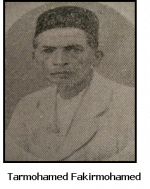Chake Chake Jamaat, Pemba, Tanzania
Brief History
Pemba known as 'Al Jazeera Al Khadra' (the green island, in Arabic) is an island forming part of the Zanzibar archipelago, lying off the east coast of Africa in the Indian Ocean. It is situated about 60 km to the north of the island of Zanzibar. It lies 50 km east of mainland Tanzania. Together with Mafia Island (south of Zanzibar), they form the Spice Islands. The estimated population of Pemba Island is about 300,000, with an area of 980 km². The island of Pemba currently has 4 districts; they are Chake Chake, Mkoani, Wete and Micheweni.
Pemba Island is the untouched and pristine island of great beauty and fertility. The mosaic of forests, swamps, mangroves, hidden beaches and lagoons is scattered with the ruins of mosques and tombs mostly reclaimed by the forest – sites that date back to Arab domination when Pemba Island was seized by the Sultan of Muscat (Oman) in the 17th century. Pemba was once the world’s major clove producer, making to almost 70%.
Janaab Tarmohamed Fakirmohamed
Tarmohamed Fakirmohamed left India in 1896 at the age of 12. He arrived first in Zanzibar and then travelled to Bagamoyo where he worked for an Ismaili community member for four years and then returned to India. In 1904, he travelled again to Pemba via Zanzibar and joined his brother Suleman Fakirmohamed in his shop. He was with his brother until 1910, after which he opened his own shop in the Chachani area, currently known as Chake Chake.
Development was in a rudimentary stage. Houses were mostly made of corrugated iron sheets with a few sturdy ones made from stone. There were no cars or vehicles of any kind. There was no electricity or piped water. Development was non-existent in what is now called the commercial area. If someone had to go to Wete-Mkoani, he had to plan a week beforehand. It would take six hours to travel by donkey. For those who opted to walk, it would take 10 hours and give one good exercise. The total distance was about 20 miles.
Chake Chake Jamaat
There were about 20 Ithnaasheri families in Chake Chake and there was a Mosque and Imambargha, majalis were being held regularly during occasions. Earlier there was an Ismaili school. Later on, the Indian Association started an Indian Public School which continued up to 1934. Then the Bohora community started their own school. The Indian Public School changed its name to Hindu Mandal School.
During this period, MKSP Mennon from India visited the community and advised that instead of having separate schools, we should all join and have one school so as to obtain a grant from the Government. The idea was accepted and a single Indian Public School was re-established. This school operated for four months and again there were misunderstandings which led to the old system of separate schools.
Mr Hussein A Rahim was the Chief Secretary of the court at that time. Due to his contacts, he was able to obtain monthly assistance of Shs: 75 from the Mohamed Merali Waqf Estate. He used this assistance to start a Madressah for teaching Holy Qur’an recitation. In 1936, the trusteeship of Mohamed Merali Trust was transferred from Haji Hussein Sheriff Dewji to Mr A R Shivji and H D Kermalli.
Madrassah
The Madressah Muallim would teach Holy Qur’an to the children in the morning and Mr Hussein A Rahim and Mulla Hassanali Noormohamed Kanji would teach religious education in the afternoon on honorary basis. Primary education was provided at the Madressah in Gujarati language. Mrs Bilimoria was employed to provide this education. After some years, a male teacher was employed following the death of Mrs Bilimoria. After the resignation of the male teacher, Mr Abdulrasul A. Rahim was employed at a salary of Shs: 75 per month.
The expenses for the Madressah were met from the Trust in Zanzibar and from the funds donated by members of the community. The school and Madressah ran very well up to 1941. A misunderstanding which ensued in the Jamaat led to a letter being sent to the Trust which stopped all assistance. This resulted in breakup and our children had to join the Hindu Mandal School.
In 1945, the Education Director, Mr Grant visited the community and advised that a single school be established and that the Government would give a grant of 66%. The separate schools were thus closed and a single Indian Public School restarted in 1957. The school is Government owned and has classes’ up to Grade 8.
- Let us remember the past leaders of Pemba Jamaats, volunteers and all Marhumeens with Sura-e-Fateha for the maghferat of their souls.
Secretariat
Africa Federation Archives Section
Reference:: https://gallery.mailchimp.com/5496132269473a782cfb7b798/files/Archives_Wete_and_ChakeChake_Jamaats.pdf


